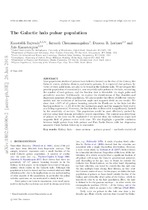The Galactic halo pulsar population

View/
Date
2018Author
Rajwade, Kaustubh
Chennamangalam, Jayanth
Lorimer, Duncan R.
Karastergiou, Aris
Metadata
Show full item recordAbstract
Most population studies of pulsars have hitherto focused on the disc of the Galaxy, the
Galactic centre, globular clusters, and nearby galaxies. It is expected that pulsars, by
virtue of their natal kicks, are also to be found in the Galactic halo. We investigate the
possible population of canonical (i.e. non-recycled) radio pulsars in the halo, estimating
the number of such pulsars, and the fraction that is detectable via single pulse and
periodicity searches. Additionally, we explore the distributions of flux densities and
dispersion measures of this population.We also consider the effects of different velocity
models and the evolution of inclination angle and magnetic field on our results. We
show that 33% of all pulsars beaming towards the Earth are in the halo but the
fraction reduces to 1.5% if we let the inclination angle and the magnetic field evolve
as a falling exponential.Moreover, the fraction that is detectable is significantly limited
by the sensitivity of surveys. This population would be most effectively probed by
surveys using time-domain periodicity search algorithms. The current non-detections
of pulsars in the halo can be explained if we assume that the inclination angle and
magnetic field of pulsars evolve with time. We also highlight a possible confusion
between bright pulses from halo pulsars and Fast Radio Bursts with low dispersion
measures where further follow-up is warranted.
